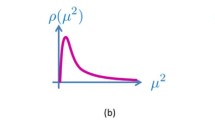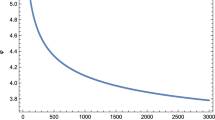Abstract
In this paper we present a new method for constructing theories of gravitation which exhibit spontaneously broken conformal symmetry. It does not require introducing nongeometric terms (i.e., auxiliary gauge fields or potential terms for the conformal field) into the Lagrangian. It is based on a theory which initially is locally both Lorentz invariant and Weyl gauge invariant inD dimensions. It is shown that, if the field Lagrangian contains terms quadratic in curvature in addition to the Ricci scalar, then the field equations allow both the dilation field and some connection components to have nonvanishing vacuum values. Both Lorentz and Weyl symmetries are thereby broken simultaneously.
Similar content being viewed by others
References
Wetterich, C. (1982).Phys. Lett.,113B, 377.
Altshuler, B. L. (1987).Phys. Rev. D,35, 3804.
Müller-Hoissen, Folkert (1986).Class. Quant. Grav.,3, L133.
Wetterich, C., and Reuter, M. (1987).Nucl. Phys. B,289, 757.
Weinberg, S. (1984).Phys. Lett.,138B, 47.
Gasperini, M. (1986).Phys. Rev. D,33, 3594.
Ross, D. K. (1983).J. Phys. A Math. Gen.,16, 3879.
Hehl, F. W., InSpin, Torsion, Rotation and Supergravity, Bergmann, P. G., and De Sabbata, V., eds. (Plenum, New York, 1980), p. 5.
Stelle, K. S. (1977).Gen. Rel. Grav.,9, 353.
Sezgin, E., and van Nieuwenhuizen, P. (1980).Phys. Rev. D,21, 3269.
Sezgin, E. (1981).Phys. Rev. D,24, 1677.
Hayashi, K., and Shirafuji, T. (1980).Prog. Theor. Phys.,64, 866.
Hayashi, K., and Shirafuji, T. (1980).Prog. Theor. Phys.,64, 883.
Kuhfuss, R., and Nitsch, J. (1986).Gen. Rel. Grav.,18, 1207.
Minkowski, P. (1977).Phys. Lett.,71b, 419.
Nieh, H. T. (1982).Phys. Lett.,88A, 388.
Zee, A. (1979).Phys. Rev. Lett.,42, 417.
Hehl, F. W., McCrea, J. D., and Mielke, E. W. (1987/1988). InExakte Wissenschaften und ihre philosphische Grundlegung. Vortrage des Internationalen Hermann-Weyl-Kongresses, Kiel 1985, Deppert, W., Hübner, K., Oberschelp, A., and Weidemann, V., eds. (Herausg, Verlag Peter Lang, Frankfurt).
Hayashi, K, Kasuya, M., and Shirafuji, T. (1977).Prog. Theor. Phys.,57, 431.
Myung, V. S., and Cho, B. H. (1986).Phys. Lett.,166B, 75.
Author information
Authors and Affiliations
Rights and permissions
About this article
Cite this article
Bradfield, T. A new approach to spontaneously broken conformal symmetry. Gen Relat Gravit 21, 665–675 (1989). https://doi.org/10.1007/BF00759076
Received:
Issue Date:
DOI: https://doi.org/10.1007/BF00759076




